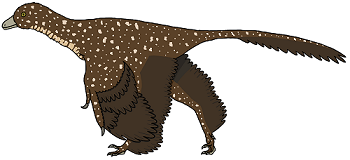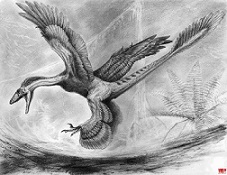
Pedopenna is a genus of extinct theropod dinosaur that lived during the Late Jurassic period stands as a pivotal chapter. Around 150 million years ago, during this epoch, a remarkable creature known as Pedopenna daohugouensis took its place in the bustling ecosystems of ancient China. Pedopenna, a genus of theropod dinosaur, would unknowingly contribute to the unraveling of one of evolution's most fascinating enigmas: the origin of flight.
The Pedopenna finds its origins in Latin, where ped signifies foot, and penna translates to feather, This etymology aptly encapsulates one of the most distinctive features of this dinosaur: feathers adorning its feet. Fossils of Pedopenna were first unearthed in the Daohugou Beds, an archeological treasure trove in Inner Mongolia, China.
| Name: | Pedopenna dinosaurs |
| Size: | Approximately length:60 centimeters(24 inches);weight:around 500 grams (1.1 pounds) . |
| Main Facts: | Pedopenna feathered Late Jurassic dinosaur with distinct feathered feet, China fossils. |
These fossils, meticulously preserved by the sands of time, have granted scientists a window into the distant past, where this small, feathered dinosaur once roamed.

The Pedopenna is intricately interwoven with the broader narrative of feathered dinosaurs and the birth of avian flight. Its existence bridges the gap between non-avian dinosaurs and the avian lineage, offering a rare glimpse into the transitional forms that paved the way for modern birds. As researchers painstakingly analyzed the fossil evidence, they discovered that Pedopenna's wings displayed an intriguing arrangement, reminiscent of the four-winged configuration seen in creatures like Microraptor.
Microraptor and its kin, collectively known as dromaeosaurs, were part of a lineage of small predatory dinosaurs with feathers on both their forelimbs and hindlimbs. These feathers formed aerodynamic surfaces that could potentially facilitate gliding or powered flight. Pedopenna's wings bore similar characteristics, suggesting that it too might have been capable of some form of aerial locomotion. However, the exact nature and extent of its flight abilities remain subjects of scientific debate.
While Pedopenna might not have been a master of the skies like modern birds, its presence in the Late Jurassic landscape provides crucial insights into the incremental steps that led to the evolution of flight. The fossils of Pedopenna illuminate the gradual transformation of limbs into wings, feathers into aerodynamic surfaces, and terrestrial predators into potential aerial adventurers.
In the grand mosaic of evolution, Pedopenna holds a significant place. Its feathered feet and winged arms beckon us to contemplate the wonders of adaptation, diversification, and innovation that have shaped life's journey on Earth. As our understanding of this enigmatic dinosaur continues to evolve, so too does our appreciation for the intricate dance of nature's forces that have sculpted the living world into what we see today.
Pedopenna , an intriguing dinosaur of the Late Jurassic period, is recognized for its remarkable fossils found in the Daohugou Beds of China. Measuring about 60 centimeters in length, this small theropod boasted a distinctive feature – feathers on its feet, a feature rarely observed in the dinosaur world. These feathered feet offer insights into its potential adaptation for unique forms of locomotion or thermoregulation strategies.
Belonging to the lineage of early birds and feathered dinosaurs, Pedopenna contributes to our understanding of the transition from land-dwelling creatures to aerial avian forms. While its wings exhibit a structure resembling the four-winged arrangement seen in Microraptor, its smaller size and distinctive foot feathers set it apart. These features prompt speculation about its lifestyle, behavior, and place within the ecosystem. As we piece together its ancient existence, Pedopenna serves as a remarkable link in the evolutionary chain, offering a glimpse into the diversity and complexity of prehistoric life.
Pedopenna's feathered structure differentiates it from many non-avian dinosaurs, showcasing the emergence of feathers in theropods.
Pedopenna's small size, around 2 feet in length, contrasts with larger predators like Spinosaurus, highlighting varied body forms.
Pedopenna's bipedal stance aligns it with many theropods, differing from quadrupedal dinosaurs like sauropods, illustrating diverse locomotion strategies.
Fossil evidence places Pedopenna in China, similar to other feathered dinosaurs like Microraptor, suggesting regional habitats.
Comparing Pedopenna's feathers to those of Archaeopteryx reveals evolutionary advancements in flight-related adaptations.
Pedopenna's potential omnivorous habits set it apart from specialized carnivores like Velociraptor, showcasing varied feeding strategies.
Pedopenna lived alongside diverse dinosaurs like sauropods and ornithopods, offering insights into interactions within the Early Cretaceous ecosystem.
Comparing Pedopenna's wing structure to that of other feathered dinosaurs provides clues about the evolution of flight-related traits.